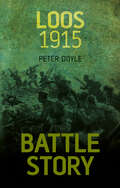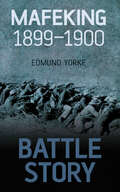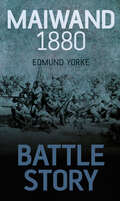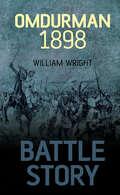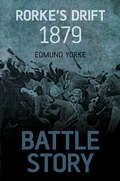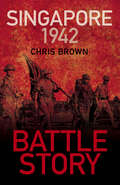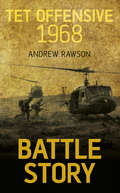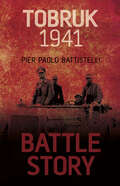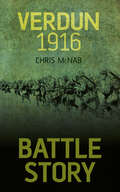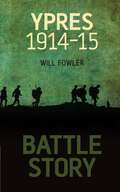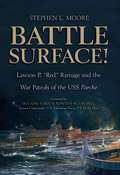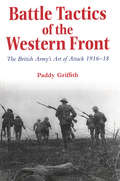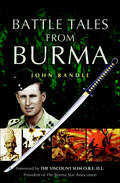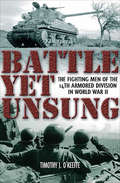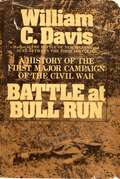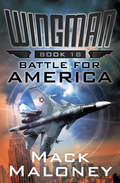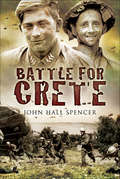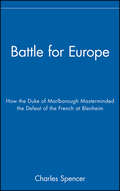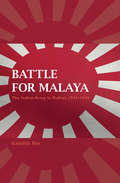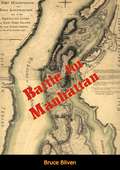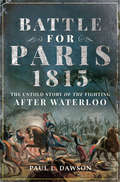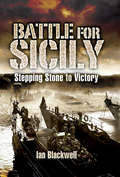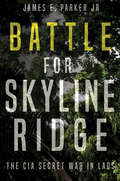- Table View
- List View
Battle Story: Loos 1915
by Peter DoyleThe Battle of Loos saw a change in Allied strategy, which up until then had been a series of small-scale assaults that achieved little or no ground gained. Loos was to be different, Kitchener’s Army was deployed in strength for the first time and an ambitious plan aimed to take ground over a 20-mile front. As the fog of war descended the first day’s gains were lost over subsequent days’ fighting and in the end the ‘Big Push’ saw little achieved with Allied losses of about 50,000 men. Through quotes and maps the text explores the unfolding action of the battle and puts the reader on the frontline. If you truly want to understand what happened and why – read Battle Story.
Battle Story: Mafeking 1899-1900
by Edmund YorkeThe Siege of Mafeking remains one of the most renowned actions of the Second Boer War, with the British Army defeating a Boer force of up to 8,000 men with barely 1,500 troops. In a siege that lasted 217 days, Robert Baden-Powell and his troops withheld attack from the Boers against all the odds and Mafeking was finally relieved on 17 May 1900. It caused much public excitement in Victorian Britain, with Baden-Powell emerging as a national hero. If you want to understand what happened and why – read Battle Story. One of the most famous, if contoversial, battles of the Second Boer War – memorialised across South Africa, Canada and the United Kingdom The Siege of Mafeking was instrumental in turning Robert Baden-Powell (later founder of the Scouts) into a national hero Includes significant contribution from South African, Canadian and Australian troops
Battle Story: Maiwand 1880
by Edmund YorkeThe Battle of Maiwand was a key clash in the Second Anglo-Afghan War and one of the most serious defeats of the British Army during the ‘Great Game’. British and Indian troops, in an attempt to intercept Afghan forces at the Maiwand Pass, disastrously underestimated the strength of the enemy and were heavily defeated. If you want to understand what happened and why – read Battle Story. Detailed profiles explore the personalities of the British and Afghan leaders, Brigadier General George Burrows and Ayub Khan. Diary extracts and quotes detail the intense fighting and the causes of the British defeat. Maps examine the movements of the British and Afghan forces as they clashed at the Maiwand Pass. Contemporary images place the reader at the forefront of the unfolding action. Orders of battle show the composition of the opposing forces’ armies. Packed with fact boxes, this short introduction is the perfect way to explore this crucial battle.
Battle Story: Omdurman 1898
by William WrightThe battle took place at Kerreri, 11km north of Omdurman in the Sudan. Kitchener commanded a force of 8,000 British regulars and a mixed force of 17,000 Sudanese and Egyptian soldiers. He arrayed his force in an arc around the village of Egeiga close to the bank of the Nile, where a gunboat flotilla waited in support, facing a wide, flat plain with hills rising to the left and right. The British and Egyptian cavalry were placed on either flank. Al-Taashi's followers, known as Ansar and sometimes referred to as Dervishes, numbered around 50,000, including some 3,000 cavalry. In a few hours and at a loss of less than 400 officers and men killed and wounded, the Anglo-Egyptian army defeated the 50,000 brave tribesmen who charged their enemy, regardless of the hail of Maxim bullets, many of them armed only with spears, swords and ancient chainmail armour. In concise detail, with orders of battle, maps and over fifty images, the author shows how Omdurman was a superb example of tactics in warfare. First-hand accounts from both sides help the reader to understand all the horrors and glory of that day including the famous charge of the 21st Lancers, often called the last great cavalry charge of the British Army. This was arguably the height of British Empire military dominance.
Battle Story: Rorke's Drift 1879
by Edmund YorkeOn 22 January 1879 a 20,000-strong Zulu army decimated the British camp at Isandlwana. On the back of this victory 3,000–4,000 Zulu warriors swept towards the garrison of Rorke’s Drift, expecting to devastate the c.500-strong British and colonial force there. However, this small, but stalwart group of brave British soldiers withstood this overwhelming force over the next forty-eight hours and ultimately repelled them in a British victory that has been immortalised in books and film. Eleven Victoria Crosses were awarded for this extraordinary feat. To understand what happened and why – read Battle Story. Moving first-hand accounts reveal the brutal nature of the battle. Biographies of the commanders and soldiers involved explore the differing tactics and motivations of both sides. Paintings, illustrations and rare photographs place you at the centre of the action. Orders of battle detail the composition of the opposing forces’ armies. Packed with fact boxes, this short introduction is the perfect way to explore this legendary battle.
Battle Story: Singapore 1942 (Battle Story)
by Chris BrownThe fall of Singapore 1942 was one of the most decisive defeats of British and Commonwealth troops in the Second World War, driven primarily by Allied complacency. If you want to understand what happened and why – read Battle Story:Detailed profiles explore the military backgrounds of the Allied and Japanese leadersComprehensive maps bring you close to the action with informative details of tactical layout of Singapore IslandPhotographs allow you to get to know the faces, equipment and terrain behind the battlePrimary accounts of the misguided British perspective of the war in the Far East appear throughoutOrders of battle reveal the composition of the British, Commonwealth and Japanese armiesPacked with fact boxes, this short introduction is the perfect way to explore this crucial battle.
Battle Story: Tet Offensive 1968
by Andrew RawsonBy the end of January 1968 the American people thought their armed forces were winning in South Vietnam after three years of escalating conflict. Then the North Vietnamese Army and Viet Cong struck back, hitting military and political targets across the country. While the NVA and Viet Cong suffered a military defeat, they dealt a huge blow to US support for the war. If you want to understand what happened and why - read Battle Story. Detailed profiles examine the background of the opposing commanders, as well as the contrasting tactics and equipment of their fighting forces. Contemporary accounts reveal the true story of this pivotal battle and its consequences for the Vietnam War. Specially commissioned maps analyse the key developments during the battle. Excellent photographs place the reader at the centre of the fighting. Orders of battle show the composition of the opposing forces’ armies.
Battle Story: Tobruk 1941
by Pier Paolo BattistelliThe siege of Tobruk lasted 240 days during which the ‘gallant garrison’ of Allied soldiers, including the famous ‘Desert Rats’ held out against constant attacks from Rommel’s Afrika Korps. The battle became one of the longest sieges in British military history and a potent symbol of British resistance. To understand what happened and why – read Battle Story. Diary extracts and quotes offer a real insight into what it was like for the Allied soldiers to live under siege. Maps highlight the adversities of the terrain and the strategic importance of the Tobruk fortress. Rare photographs place you on the frontline of the unfolding action. Orders of battle reveal the composition of the opposing forces’ armies. Packed with fact boxes, this short introduction is the perfect way to explore this important battle.
Battle Story: Verdun 1916
by Chris McNabThe Battle of Verdun was one of the bloodiest engagements of the First World War, resulting in 698,000 deaths, 70,000 for each of the 10 months of battle. The French Army in the area were decimated and it is often most tragically remembered as the battle in which the French were ‘bled white’. A potent symbol of French resistance, the fortress town of Verdun was one that the French Army was loath to relinquish easily. It was partly for this reason that the German commander chose to launch a major offensive here, where he could dent French national pride and military morale. His attack commenced on 21 February, using shock troops and flamethrowers to clear the French trenches. Starting with the capture of Fort Douamont, by June 1916 the Germans were pressing on the city itself, exhausting their reserves. The French continued to fight valiantly, despite heavy losses and eventually rolled back German forces from the city. In the end it was a battle that saw much loss of life for little gain on either side.
Battle Story: Ypres 1914-1915
by Will FowlerYpres was a medieval town known for its textiles; however, it became infamous during the Great War with trench warfare, poison gas and many thousands of casualties. As the German Army advanced through Belgium, it failed to take the Ypres Salient. On 13 October 1914, German troops entered Ypres. On looting the city, the Germans retreated as the British Expeditionary Force advanced. On 22 November 1914, the Germans commenced a huge artillery barrage killing many civilians. In 1917, the Third Battle of Ypres commenced making it an exceptionally dangerous place to live. In 1918, a German major offensive was launched, but the British held firm. Ypres was finally safe in late September 1918 when German troops withdrew from the Salient. Today the battlefields of Ypres contain the resting place of thousands of German and British soldiers. This book explores the first and second battles of Ypres through narrative, eye-witness accounts and images.
Battle Surface!
by Stephen L. MooreCmdr. Lawson Paterson Red Ramage was among an elite group of just seven U.S. submariners who were awarded the Medal of Honor during World War II and the first not to die in the course of his heroic exploits. He was honored for his actions in the Pacific on the night of 31 July 1944 when he kept his submarine, USS Parche, on the surface and defiantly charged into the midst of a large Japanese convoy. Ramage's close-in, furious surface rampage became the talk of the submarine force, both in terms of its boldness and its destruction of the enemy shipping. Remarkably, Parche's crew had managed to reload their torpedo tubes while their skipper twisted and turned the boat through the chaos of machine gun bullets, exploding heavy shells, and Japanese ships trying to ram them.To tell Parche's dramatic story, author Stephen Moore draws on recently discovered wartime diaries and interviews with dozens of veterans, who add rich details to the official record. Readers learn what it was like on patrol in the Pacific to endure the terrors of torpedo attacks and depth charges, as well as learn how they relieved the stress of combat on liberty. The only book to focus exclusively on Parche and the incredible Red Ramage, it offers a rare, up-close look at the actions of the legendary World War II submarine, whose conning tower and periscopes are on permanent display in Pearl Harbor.
Battle Tactics of the Western Front
by Paddy GriffithHistorians have portrayed British participation in World War I as a series of tragic debacles, with lines of men mown down by machine guns, with untried new military technology, and incompetent generals who threw their troops into improvised and unsuccessful attacks. In this book a renowned military historian studies the evolution of British infantry tactics during the war and challenges this interpretation, showing that while the British army's plans and technologies failed persistently during the improvised first half of the war, the army gradually improved its technique, technology, and, eventually, its' self-assurance. By the time of its successful sustained offensive in the fall of 1918, says Paddy Griffith, the British army was demonstrating a battlefield skill and mobility that would rarely be surpassed even during World War II.Evaluating the great gap that exists between theory and practice, between textbook and bullet-swept mudfield, Griffith argues that many battles were carefully planned to exploit advanced tactics and to avoid casualties, but that breakthrough was simply impossible under the conditions of the time. According to Griffith, the British were already masters of "storm troop tactics" by the end of 1916, and in several important respects were further ahead than the Germans would be even in 1918. In fields such as the timing and orchestration of all-arms assaults, predicted artillery fire, "Commando-style" trench raiding, the use of light machine guns, or the barrage fire of heavy machine guns, the British led the world. Although British generals were not military geniuses, says Griffith, they should at least be credited for effectively inventing much of the twentieth-century's art of war.
Battle Tales from Burma
by John RandleA collection of autobiographical stories from an officer in the British Indian Army during World War II. John Randle served with the greatly respected Baluch Regiment of the former Indian Army right through the fiercely fought Burma Campaign, winning a Military Cross, yet on VJ Day he was only some sixty miles from where had started out nearly four years before. Unlike other conventional war memoirs, this book comprises a gratifying number of self-contained stories drawn from the author&’s experiences and memories. Some are long, other mere vignettes; some are moving and serious, others are light-hearted even humorous. Some cover hard-won victories and success, others defeats and reversal; some describe acts of great valor, others incidents reflecting human frailties. All however, are worth reading and give a very accurate picture of war at its bitterest, when men are drawn together and individuals are under that most demanding microscope of their fellow comrades-in-arms.
Battle Yet Unsung: The Fighting Men of the 14th Armored Division in World War II
by Timothy J. O'Keeffe&“An incredible job in shedding light about an often neglected but important role this unit played in the defeat of Nazi Germany&” (WWII History). While headline writers in the European Theater of Operations were naturally focused on events in Normandy and the Bulge in the north, equally ferocious combats were taking place in southern France and Germany during 1944–45, which are now finally getting their due. The US 14th Armored Division—a late arrival to the theater—was thrust into intense combat almost the minute it arrived in Europe, as the Germans remained determined to defend their southern flank. This book explores in detail what happened in the month of January 1945 in the snow-covered Vosges Mountains, when the Wehrmacht&’s attempt to destroy the Sixth Army Group failed. A strategic withdrawal after ten hellish days of fiery combat allowed the Allies to hold the line until a spring offensive. In March, the division literally exploded its way through the Siegfried Line at Steinfeld and began to propel the Wehrmacht into a retreat from which it could never recover. Armored columns kept punching their way through roadblock after roadblock in town after town with powerful artillery and air concentrations that never gave the German soldiers a chance to respond. As a result of the rapid advance of Seventh Army and the 14th, German POW camps like the ones at Hammelburg and Moosburg were liberated of over 100,000 prisoners, an achievement which gave the division the nom de guerre &“The Liberators.&” &“A frontline soldier&’s view of how green troops became battle-wise and battle-weary veterans.&” —The Journal of America&’s Military Past
Battle at Bull Run: A History of the First Major Campaign of the Civil War
by William C. DavisTwo great, untested armies were readying for the first--and what many believed would be the last--major conflict between North and South. On the eve of July 21, 1861, one Northerner wrote: "The sky is perfectly clear, the moon is full and bright, and the air was still as if it were not within a few hours to be disturbed by the roar of cannon and the shouts of contending men." So optimistic were the people in Washington that a crowd of civilians came from the city with picnic hampers to witness the crushing defeat of the upstart "rebels." It was, says William C. Davis, "the twilight of America's innocence," and the following day the mood would shatter in a battle that confounded the expectations of both sides--the first Battle at Bull Run. William C. Davis has written a compelling and complete account of this landmark conflict. The Battle at Bull Run (or Manassas) is notable for many reasons. It was a surprise victory for the Confederacy, a humiliating defeat for the Union, and the first ominous indication that a long and bloody war was inevitable. It marked the first strategic use of railroads in history, and the first time the horrors of the battle were photographed for the folks back home. It was also a training ground for some of America's most colorful military figures: P.G.T. Beauregard, Joe Johnston, Irvin McDowell and "Stonewall" Jackson. Drawing from a wealth of material--old letters, journals, memoirs and military records--Davis brings to life a vivid and vital chapter in American history.
Battle for America (Wingman #18)
by Mack MaloneyAn ace fighter pilot aims to save a shattered America from Russian invasion in this new Wingman novel from &“the best high-action thriller writer out there&” (Jon Land). Former US Air Force major Hawk Hunter and his band of patriotic ex-military men have fought tirelessly to reunite their fractured nation after the Russian nuclear sneak attack that put a devastating end to World War III. Now, returning from a space odyssey that began with the diversion of a comet headed for Earth, Hunter finds a 60,000-man Russian army occupying New York City, ready to invade the rest of America. Equally alarming are reports claiming that Hawk&’s former girlfriend, Dominique, is living with the head of the Russian secret police in a Manhattan penthouse. Buzzing through the city&’s skyscraper canyons in a tiny STOL Highlander and glimpsing the enemy invaders&’ massive weaponry for himself, Hawk realizes he&’s up against the greatest danger his homeland has ever faced, even with the help of Captain &“Bull&” Dozer and his team of ex-Marines. But with the woman and the country he loves in dire peril, threatened by a mysterious convoy of Russian superships, the Wingman will apply all his aviation prowess and strategic ingenuity to devise a plan to launch the fiercest, most crucial battle for America yet, no matter the risks. Filled with fast-paced, furious action and a wide range of aircraft and military hardware that will fascinate techno-thriller fans, Battle for America brings back favorite characters from earlier books in the series and delivers a riveting story that reveals new insight on America&’s most enigmatic hero: the Wingman.
Battle for Crete
by John Hall SpencerThis WW2 military history “combin[es] a look at the background to the battle . . . and the ground level memories of the participants with great skill.” (History of War.org)After two years’ extensive research, John Hall Spencer has written a thorough account of the political and military background to the German invasion of Crete and the bitter fighting that followed the first airborne assault on an island in history. Battle for Crete tells of confused negotiations between the British and Greek governments; the misunderstandings between Winston Churchill’s War Cabinet and commanders in the field; the near capture of the King of Greece; the lack of preparation by the defenders and the suppression of a critical post-battle report by General Wavell.There are vivid eyewitness accounts of the fighting both during the invasion and the subsequent campaign and ultimate retreat and evacuation. The Royal Navy and Royal Air Force’s contribution is well documented, as are the roles of the German air force, in this “close run” campaign fought with aggression by both sides.
Battle for Europe: How the Duke of Marlborough Masterminded the Defeat of the French at Blenheim
by Charles SpencerA &“wondrously enthralling&” history of the bloody battle that ended Louis XIV&’s dream of European domination (The Times, UK). In 1704, the armies of French King Louis XIV were poised to extend the French frontiers to the Rhine and install a French prince on the Spanish throne. But as French forces marched toward Vienna, allied armies commanded by John Churchill, Duke of Marlborough, and Prince Eugene of Savoy set out to oppose them. The two forces clashed at Blenheim, in Bavaria, and the previously undefeated French were routed. Based on original sources, this &“thoughtful, interesting, and well-written&” narrative brings the battle to life, capturing the deliberations of kings as well as the experiences of ordinary soldiers (The Sunday Telegraph, UK).
Battle for Malaya: The Indian Army in Defeat, 1941–1942 (Twentieth-century Battles Ser.)
by Kaushik RoyThe historian and author of The Army in British India analyzes the British Indian Army’s devastating loss to the Imperial Japanese during WWII.The defeat of 90,000 Commonwealth soldiers by 50,000 Japanese soldiers made the World War II Battle for Malaya an important encounter for both political and military reasons. British military prestige was shattered, fanning the fires of nationalism in Asia, especially in India. Japan’s successful tactics in Malaya—rapid marches, wide outflanking movement along difficult terrain, nocturnal attacks, and roadblocks—would be repeated in Burma in 1942–43. Until the Allied command evolved adequate countermeasures, Japanese soldiers remained supreme in the field. Looking beyond the failures of command, Kaushik Roy focuses on tactics of the ground battle that unfolded in Malaya between December 1941 and February 1942. His analysis includes the organization of the Indian Army—the largest portion of Commonwealth troops—and compares it to the British and Australian armies that fought side by side with Indian soldiers. Utilizing both official war office records and personal memoirs, autobiographies, and oral histories, Roy presents a comprehensive narrative of operations interwoven with tactical analysis of the Battle for Malaya.
Battle for Malaya: The Indian Army in Defeat, 1941–1942 (Twentieth-century Battles Ser.)
by Kaushik RoyThe historian and author of The Army in British India analyzes the British Indian Army’s devastating loss to the Imperial Japanese during WWII.The defeat of 90,000 Commonwealth soldiers by 50,000 Japanese soldiers made the World War II Battle for Malaya an important encounter for both political and military reasons. British military prestige was shattered, fanning the fires of nationalism in Asia, especially in India. Japan’s successful tactics in Malaya—rapid marches, wide outflanking movement along difficult terrain, nocturnal attacks, and roadblocks—would be repeated in Burma in 1942–43. Until the Allied command evolved adequate countermeasures, Japanese soldiers remained supreme in the field. Looking beyond the failures of command, Kaushik Roy focuses on tactics of the ground battle that unfolded in Malaya between December 1941 and February 1942. His analysis includes the organization of the Indian Army—the largest portion of Commonwealth troops—and compares it to the British and Australian armies that fought side by side with Indian soldiers. Utilizing both official war office records and personal memoirs, autobiographies, and oral histories, Roy presents a comprehensive narrative of operations interwoven with tactical analysis of the Battle for Malaya.
Battle for Manhattan
by Bruce Bliven Jr.First published in 1956, this book by ex-WWII lieutenant Bruce Bliven, Jr. tells the story of the three-day battle of Manhattan, New York in September 1776, which saw George Washington preserving his army during a long retreat from the British troops.At the time of its first release, the book drew praise for using present-day names for locations to put historic events in perspective, a technique the author referred to as “terrain appreciation,” rounding out the book with authenticated descriptions of New York in 1776 that will leave the reader captivated.“Bliven’s book—a virtually perfect example of the military monograph—consistently reminds readers that these are not distant and alien battlefields he’s talking about; indeed, this is ground thousands of New Yorkers now commute across without a second thought…”—Steve Donoghue, Stevereads
Battle for Paris 1815: The Untold Story of the Fighting After Waterloo
by Paul L. Dawson&“For anyone seeking a full understanding of the end of the Napoleonic era this book is a must read . . . [a] tour de force of research.&” —Clash of Steel On the morning of 3 July 1815, the French General Rémi Joseph Isidore Exelmans, at the head of a brigade of dragoons, fired the last shots in the defense of Paris until the Franco-Prussian War sixty-five years later. Why did he do so? Traditional stories of 1815 end with Waterloo, that fateful day of 18 June, when Napoleon Bonaparte fought and lost his last battle, abdicating his throne on 22 June. But Waterloo was not the end; it was the beginning of a new and untold story. Seldom studied in French histories and virtually ignored by English writers, the French Army fought on after Waterloo. Many commanders sought to reverse that defeat—at Versailles, Sevres, Rocquencourt, and La Souffel, the last great battle and the last French victory of the Napoleonic Wars. Marshal Grouchy, much maligned, fought his army back to Paris by 29 June, with the Prussians hard on his heels. On 1 July, Vandamme, Exelmans and Marshal Davout began the defense of Paris. Davout took to the field in the north-eastern suburbs of Paris along with regiments of the Imperial Guard and battalions of National Guards. For the first time ever, using the wealth of material held in the French Army archives in Paris, along with eyewitness testimonies from those who were there, Paul Dawson brings alive the bitter and desperate fighting in defense of the French capital. The 100 Days Campaign did not end at Waterloo, it ended under the walls of Paris fifteen days later.
Battle for Paris 1815: The Untold Story of the Fighting After Waterloo
by Paul L. Dawson&“For anyone seeking a full understanding of the end of the Napoleonic era this book is a must read . . . [a] tour de force of research.&” —Clash of Steel On the morning of 3 July 1815, the French General Rémi Joseph Isidore Exelmans, at the head of a brigade of dragoons, fired the last shots in the defense of Paris until the Franco-Prussian War sixty-five years later. Why did he do so? Traditional stories of 1815 end with Waterloo, that fateful day of 18 June, when Napoleon Bonaparte fought and lost his last battle, abdicating his throne on 22 June. But Waterloo was not the end; it was the beginning of a new and untold story. Seldom studied in French histories and virtually ignored by English writers, the French Army fought on after Waterloo. Many commanders sought to reverse that defeat—at Versailles, Sevres, Rocquencourt, and La Souffel, the last great battle and the last French victory of the Napoleonic Wars. Marshal Grouchy, much maligned, fought his army back to Paris by 29 June, with the Prussians hard on his heels. On 1 July, Vandamme, Exelmans and Marshal Davout began the defense of Paris. Davout took to the field in the north-eastern suburbs of Paris along with regiments of the Imperial Guard and battalions of National Guards. For the first time ever, using the wealth of material held in the French Army archives in Paris, along with eyewitness testimonies from those who were there, Paul Dawson brings alive the bitter and desperate fighting in defense of the French capital. The 100 Days Campaign did not end at Waterloo, it ended under the walls of Paris fifteen days later.
Battle for Sicily: Stepping Stone to Victory
by Ian BlackwellOn the night of 9-10 July 1943, an Allied armada launched the invasion of Sicily, a larger operation than the Normandy landings the following year. Over the next thirty-eight days, half a million Allied servicemen fought the Germans and Italians for control of this rocky island, which was to become the first part of Axis homeland to fall during World War II.Despite their success in capturing the island, inter-Allied and inter-service divisions and rivalries robbed them of the opportunity to inflict a crushing defeat on the Germans and Italians, who were able to conduct a fighting withdrawal to the Italian mainland and save sizable forces to continue the war. Regarded by some as a "blind alley" and by others as the way into Europe via the "soft underbelly", the decision to invade Sicily was and remains controversial. Notwithstanding the campaigns failure to achieve its potential, invaluable lessons were learned which contributed to success in France later. Many of the leading generals who were to take prominent roles in northwest Europe amongst them Eisenhower, Montgomery, Bradley and Patton brought with them the experience of Sicily.
Battle for Skyline Ridge: The CIA Secret War in Laos
by James E. Parker Jr.&“An incredibly powerful account of a little-known chapter in the Vietnam War saga&” written by a CIA veteran who fought in the Secret War (Booklist, starred review). In the 1960s and &’70s, the Laotian Civil War became a covert theater for the conflict in Vietnam, with the US paramilitary backing the Royal Lao government in what came to be known among the CIA as the Secret War. In late 1971, the North Vietnamese Army launched Campaign Z, invading northern Laos on a mission to defeat the Royal Lao Army. General Giap had specifically ordered the NVA troops to kill the CIA army and occupy its field headquarters in the Long Tieng valley. The NVA faced the small rag-tag army of Vang Pao, mostly Thai irregulars recruited to fight for the CIA. But thousands more were quickly recruited, trained, and rushed into position in Laos to defend against the impending NVA invasion. Despite overwhelming odds in the NVA&’s favor, the battle raged for more than one hundred days—the longest battle in the Vietnam War. In the end, it all came down to Skyline Ridge. Whoever won Skyline, won Laos. Historian James E. Parker Jr. served as a CIA paramilitary officer in Laos. In this authoritative and personal account, Parker draws from his own firsthand experience as well as extensive research into CIA files and North Vietnamese after-action reports in order to tell the full story of the battle of Skyline Ridge.
